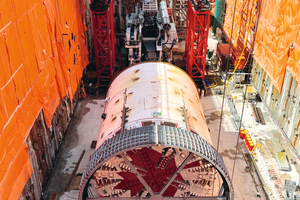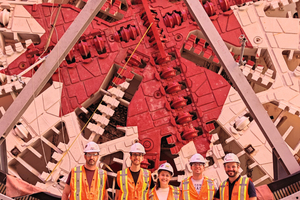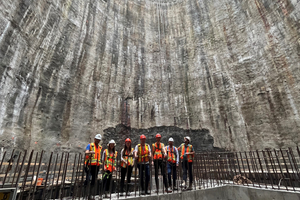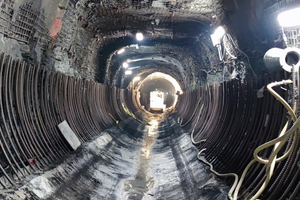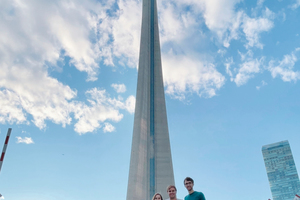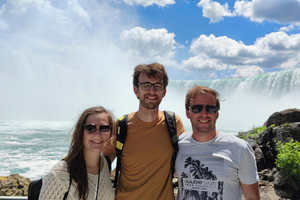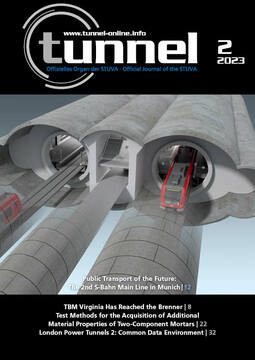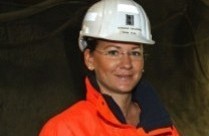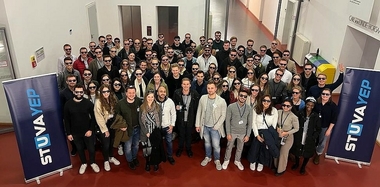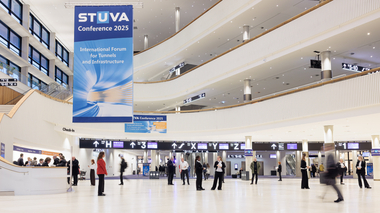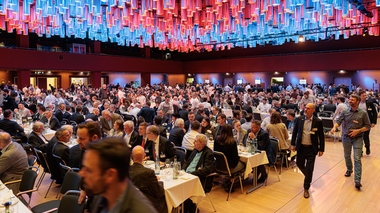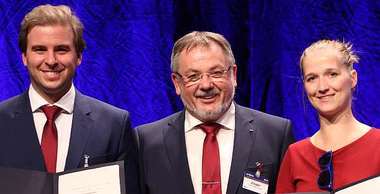Young Forum of the STUVA Conference:
Three Winners Share Exciting Journey in Canada
When the STUVA Conference ‘23 opens its doors in Munich on November 8 this year, there will definitely be excitement once again. Because in the STUVA “Young Forum” competition, up to five young engineers will be given the chance to present their projects or research topics on the big stage and face evaluation by the attending expert audience. The rapidly increasing number of participants shows how popular this competition, now in its seventh year, has become among young professionals. With 17 submissions this year, an all-time record was set, which does not exactly make the pre-selection for the Scientific Program Advisory Board easy. We can therefore look forward to seeing who will make it to the final round this year and win the Young Talent Awwrd. As always, not only fame and honor await the winner, but also an exclusive trip to one of the major tunnel construction projects.
In the last three years, however, travelling was not the easiest thing to do ... At the STUVA Conference 2019, Dr.-Ing. Ivan Popovic of ZPP Ingenieure received the STUVA Young Talent Award for his presentation “New separation method for used bentonite suspensions: Fine particle separation by electroagulation – laboratory tests, prototype, site implementation.” But the anticipation of his planned trip to the Alto Maipo hydropower plant megaproject in Chile lasted only briefly. The outbreak of the Corona pandemic threw a wrench in all travel plans.
Two years passed quickly, and the 2021 STUVA Conference arrived, and because there was a tie vote, the STUVA Young Talent Award was given to two winners: Sebastian Kube, M. Sc. from the Chair of Tunneling, Pipeline Construction and Construction Operations at Ruhr University Bochum (at the time of the STUVA meeting; now Reckli) for his paper “Electrical resistivity measurements to describe particle incorporation during penetration of bentonite into cohesionless soil” and Sophie Escherich, M. Sc. from Gähler und Partner for her paper “Organization of large underground construction projects in Germany and Switzerland – A comparative view on success criteria.”
The prize included a trip to Toronto, Canada, to visit the construction sites of the Scarborough Subway Extension and Ashbridges Bay Wastewater Treatment Plant – Integrated Pumping Station projects. But even these two winners initially had to wait months for their trip due to Corona-related restrictions. When casual travel finally became possible again, the decision was quickly made: All three young winners would embark on the trip organized by STRABAG and STUVA together. In the meantime, the travel group has arrived back home safe and sound and has brought us the following travel report:
Arrival in Toronto
The day of arrival, which we had been looking forward to, had finally arrived. We met at Frankfurt airport at 6 a.m. and our departure was shortly after 10 a.m. When we arrived in Toronto after an 8-hour flight, the clock there showed only noon. So we still had a whole day ahead of us and used it to have a look at the city.
With almost 3 million inhabitants, Toronto is the largest city in Canada and the capital of the province of Ontario. With about 50% of its residents born outside of Canada, Toronto is considered one of the most multicultural and cosmopolitan cities in the world. On the first day we visited Toronto Downtown, which is known for its many skyscrapers. There were construction sites everywhere with a wide variety of engineering tasks, from civil engineering to building the final floors of new skyscrapers. We were already excited to see what would await us at the STRABAG construction sites over the next few days.
Welcoming at STRABAG Headoffice and Talk About Company Activities in Canada
The next morning we drove to the head office of STRABAG Canada in Mississauga and were warmly welcomed by Simon Köck and his team. After a tour of the office in the new building, which is conveniently located right next to a STRABAG construction site, we were introduced to the completed and ongoing projects in Canada. STRABAG established itself in Canada with the Niagara Tunnel project, which was completed in 2013 after seven years of construction. The world’s largest hard rock TBM at the time (diameter 14.4 m, length 150 m, weight more than 4000 t) had been used there to build a 10.4 km long water supply tunnel. The tunnel is located up to 140 m below the surface and is used to feed a storage reservoir, enabling more intensive use of the Niagara River for power generation. The construction cost amounted to 900 million euros.
During the presentation of the current projects, we were particularly impressed by how intensively BIM is already being used in the bidding process. In addition to BIM, we also discussed many other aspects, in particular the differences between European and Canadian planning and execution of major projects. After lunch together, we went to the first construction site – the starting shaft for the Scarborough subway extension project.
Scarborough Subway Extension – Launch Shaft
STRABAG, through its Canadian subsidiary, has been awarded the tunnel construction contract for the Scarborough subway extension (Line 2) in Toronto. The project, with a contract volume of around 500 million euros, was tendered as a design-build-finance model. Work started in June 2021 and is scheduled for completion by fall 2024. The Scarborough Subway extension is a key part of Ontario’s 21.1 billion euros subway expansion program, which also includes the Ontario Line, the Yonge North Subway Extension and the Eglinton Crosstown West Extension. In total, more than 40 km of new subway lines will be built as part of this expansion program.
The 7.8 km extension of the Scarborough Subway will be entirely underground. It will connect the current terminus at Kennedy Station with Sheppard Avenue/McCowan Road. STRABAG’s current contract includes a launch shaft, a target shaft, five headwalls for future stations and 14 headwalls for rescue shafts. A tunnel boring machine with a diameter of approx. 11.9 m will be used for tunnel construction. The stations and train systems will then be built in the next construction phase.
When we arrived, the tunnel boring machine named “Diggy Scardust” was already in the starting shaft. Diggy is a 2050-ton, 84-meter-long EPB shield machine made by Herrenknecht. It will construct a subway tunnel with an internal diameter of 10.7 m, in which trains can travel in both directions – the first of its kind in Toronto.
The launch shaft itself is 28 m wide, 80 m long and 30 m deep. More than 300 secant bored piles were constructed to build the watertight wall around the pit. We went down into the shaft and had a look at the shield TBM – which is something tunnellers always enjoy doing. The cutting wheel features the maple leaf, the Canadian national symbol, in white and red. After the launch shaft and the shield TBM, we also looked at the rest of the site installations.
After this eventful day, we had a free evening to explore the city further. The following day, a visit to the next construction site was on the agenda: the integrated pumping station of the Ashbridges Bay wastewater treatment plant.
Ashbridges Bay Wastewater Treatment Plant – Integrated Pumping Station
Early in the morning of the third day, we arrived at the site office. There we first had a typical Canadian breakfast with donuts. This was followed by a presentation of the project by the employees on site.
The Canadian unit of the STRABAG Group has been contracted by the City of Toronto to build the second phase of the new integrated pumping station at the Ashbridges Bay wastewater Treatment Plant. The contract is worth around 80 million euros and includes shaft and feeder structures. The integrated pumping station will enable wastewater to be discharged underground to the Ashbridges Bay wastewater treatment plant. The pumping station is part of a larger infrastructure program aimed at increasing capacity in the wastewater system for heavy rain events, improving water quality in Toronto’s waterways and Lake Ontario.
The centerpieces of the construction project are two massive shafts: one 68 m deep and 27 m in diameter, and another 27 m deep and 32 m in diameter. Including five smaller shafts, this makes a total of 153 m of shaft structures to be built. The two large shafts are served by feeder tunnels, which are cut into rock for a total length of 445 m, and a parallel pressure pipe, which is being constructed close to the surface using the cut-and-cover method.
We first looked at the deepest shaft, into which we were taken down in a crane basket. The shaft was no longer “just” a shaft – inside, work had already begun on the future pumping station. In a feeder tunnel, we could see the soil or rocks in the deep underground of Toronto, as the tunnel was partially excavated without shotcrete lining. After the first shaft, we also went down into the second adjacent shaft. In the afternoon we said goodbye to our hosts.
Toronto and Niagara Falls
In addition to impressive construction sites, we also visited numerous sights in Toronto and the surrounding area. The most famous landmark of Toronto is the CN Tower, a 553 m high television tower, which was built in the 1970s on behalf of the Canadian National Railways. The tower was built to improve radio transmission and was not originally intended to be open to the public. Today it is the city’s main tourist attraction. From its observation decks, Toronto can be admired in all its glory.
The tower is located in Toronto Downtown, which is a sight in itself. This area is home to the largest concentration of skyscrapers and businesses in Canada, which shape the Toronto skyline. Toronto Downtown has the third most skyscrapers in North America after New York and Chicago. With tower cranes and new skyscrapers dominating the cityscape, Toronto is poised to overtake Chicago on this list in the coming years.
Toronto is incredibly interesting – not only right below the clouds, but beneath the surface as well. Toronto’s skyscrapers are connected underground by what is known as the PATH. This is a network of 30 km of pedestrian tunnels under the city center. But PATH is much more than just a tunnel system, it is like a shopping mall. There are currently about 1200 stores connected to PATH, with more than 200 000 daily users, who have direct access to PATH via several subway stations. This is very convenient, especially during the winter months.
And last but not least ... Niagara Falls. This natural wonder is located only about 130 km from Toronto, on the border between the U.S. and Canada. The most famous falls, Horseshoe Falls, are 57 m deep and 670 m wide. Although the water masses at the falls seemed to be infinite, they amount to only about half of the total water flow of the Niagara River. The rest is diverted for power generation. With more than 18 million visitors annually, the Niagara region is one of the most popular tourist attractions in North America.
Summary
We found the trip we won both informative and incredibly exciting. Overwhelmed by the impressions, we would like to thank STUVA and STRABAG for organizing the trip. We would especially like to thank Stefanie Posch (STUVA) as well as Simon Köck and his colleagues (STRABAG), who warmly welcomed us, presented their projects and showed us the construction sites.

